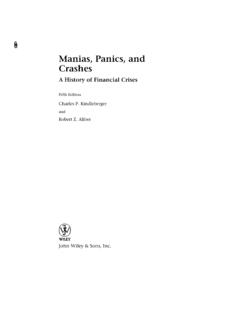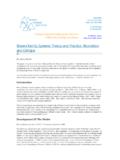Transcription of The Future of the Automotive Value Chain 2025 and beyond
1 The Future of the Automotive Value Chain2025 and beyond The Future of the Automotive Value Chain | 2025 and beyond03 Preface 05 Drivers that will shape the Automotive industry over the next decade 06 The Automotive Value Chain in 2025: four plausible scenarios 12An OEM in the year 2025 20 Transformation paths towards the Value Chain of the Future 38 Conclusion 61 Contacts 6204 The Future of the Automotive Value Chain | 2025 and beyond05 News of disruptive, even historical, changes in the Automotive ecosystem has domi-nated industry debates in recent years.
2 Fundamental readjustments to the whole Automotive Value Chain seem inevitable. It is still not clear, however, where the journey will end, as many developments are still speculative. For example: when will e-mobility (finally) be broadly accepted in the market? Despite all this uncertainty, Automotive leaders are required to make investment decisions today, in order to have know-how, production capacity, and stable supply chains in place once markets demand them. Decision-makers are feeling pressure to act. The question is: what are the right decisions in these uncertain times? With the study Automotive Value Chain 2025 and beyond , we are aiming at pro-viding approaches and tools to support Automotive decision-makers in answering this question. We cooperated closely with established Automotive researchers and Preface practitioners and identified the most important drivers of Future Value Chain de-velopments.
3 We focused on the upstream part of the Value Chain , from R&D to outbound logistics, as we expect massive implications for assets, people, and supply structures in this area. For this we applied the approach of scenario-based business modeling: we identified four plausible setups an OEM s Value Chain might have in the year 2025. We are already using the results of our model calculations today to help Automotive decision-makers challenge their own forecasts and strategic plans systematically. By publishing this study, we are pleased to share our thinking now with the broader public. Most of the scenarios developed in the study demand a significant willingness to change on the part of Automotive OEMs. Today s Value Chain decisions will without doubt have massive implications for Future assets, employee numbers, and supplier structures across the Automotive ecosystem.
4 Scenarios and model calculations can be very valuable for supporting such landmark decisions. The pace and impact of current changes call more than ever for bold action today. We hope you enjoy reading our insights and thoughts on the Future of the automo-tive Value Nikolaus HelbigPartner | Strategy & Operations at Deloitte Consulting Dr. J rgen Sandau Partner | Strategy & Operations at Deloitte Consulting Jens HeinrichDirector | Strategy & Operations at Deloitte ConsultingDisruptive times ahead for the Automotive Value chain06 The Automotive industry is in the midst of an historic change right before our eyes. Nearly every day we read in the news about an actual or Future shake-up in the market, new business models, or a new Value Chain . Enthusiastic voices are pointing at excellent opportunities for the customer, the environment, or for business.
5 Drivers that will shape the Automotive industry over the next decadeThe Future of the Automotive Value Chain | 2025 and beyond0708 The unpredictable futureDespite promises of a brighter and better Automotive Future , more and more critical voices are making themselves heard and are asking very pragmatic questions: how can traditional Automotive OEMs remain competitive in the face of increasing pres-sure from major tech players with pockets full of cash that they are willing to invest? What impact will the increasing importance of software and connected services in cars have on R&D capabilities and supplier selection? What kind of asset structure will be needed to provide mobility and digital services? How can people be trained to ensure they possess a digital skill set ? How to deal with the fact that electric engines contain far fewer components than combustion engines, implying thousands of potentially redundant workers?
6 And what impact will all of this have on the economy in and around cities and regions which de-pend on the jobs that carmakers provide? This study attempts to shed some light on possible developments in the Automotive Value Chain as it progresses towards 2025. Our aim is to support our readers and facilitate decision-making in times of great uncertainty by developing a strategy that takes into account several relevant scenar-ios. We therefore quantify the effects in each scenario in order to be able to make educated decisions and to support OEMs in acting as strategic players to shape the Automotive Value Chain the way they desire into 2025 and beyond . Which cars are needed intimes of increasing urbanization and expanding public transportation?The connected electric vehicle technology push or market pull?
7 Should OEMs produce batteries for e-cars themselves?Where will carmakers revenues come from in 2025?If an OEM sells only mobility services, who will assemble the cars?Will OEMs have recaptured the technology Chain , reintegrating suppliers?Is it ethical to monetizesensitive private data?Will OEMs still sell cars directly to end customers?What will cars look like in 2025?Fig. 1 Questions carmakers are currently asking themselvesThe Future of the Automotive Value Chain | 2025 and beyond09 Study approach No one has a crystal ball to predict the Future . Nevertheless, there are some signposts to Future developments to be seen almost every day: market launches of autonomous cars or press statements announcing thousands of job cuts, to name just two examples. These signposts are not necessarily pointing the same way.
8 Thinking in scenarios can help here. Decision-makers need to understand the underlying dynam-ics that will shape the Future so as to take the right strategic decisions in the face of uncertainty. In the course of a large number of inter-views with experts representing Automotive OEMs, mobility entrepreneurs, researchers, lobbyists as well as IT and battery develop-ers, we identified more than 60 drivers that are most likely to shape the Future of the Automotive Value Chain . These drivers backed by extensive re-search data were ranked and fused into four scenario narratives, giving an outline of what the Automotive Value Chain might look like in 2025. On the basis of these sce-nario narratives we conducted workshops with top managers from Automotive OEMs and independent industry experts in order to challenge and fine-tune the narratives.
9 These discussions resulted in a series of implications for the market and the Value Chain , and also some strategic imperatives for OEMs in each of the four scenarios. 10 Since the aim is to facilitate decision-mak-ing in the face of uncertainty, it is essential to quantify projected market shifts and their implications for the Value Chain . On the basis of our scenario narratives and profit models, Deloitte financial benchmark databases, and forecast driver develop-ments we modeled the income statement and balance sheet for a typical OEM in 2025 in each of the four scenarios. Computing financial performance indicators for each of the scenarios allows prioritizing strategic decisions. Understanding how sin-gular initiatives impact the overall financial success, stability, and workforce of a com-pany is of great Value when having to assess different options.
10 Even more so, when great numbers and clusters of strategic decisions have to be evaluated in an integrated man-ner along different potential scenarios. Of course, financial modeling reaching so far into the Future can never be 100% accurate. But even obtaining an understanding of the orders of magnitude of potential financial implications is highly valuable for decision making. Monitoring development signposts and quantifying their effects in an integrated financial model sheds light on mission-critical transformation , outlining projected OEM profit models and KPIs in 2025 will not answer two important questions all decision-makers will ask: how do we get there and where do we start? This study therefore concludes with sketches of possible Value Chain transformation paths for OEMs from today until 2025, and also pain points that might be expected along the way.













